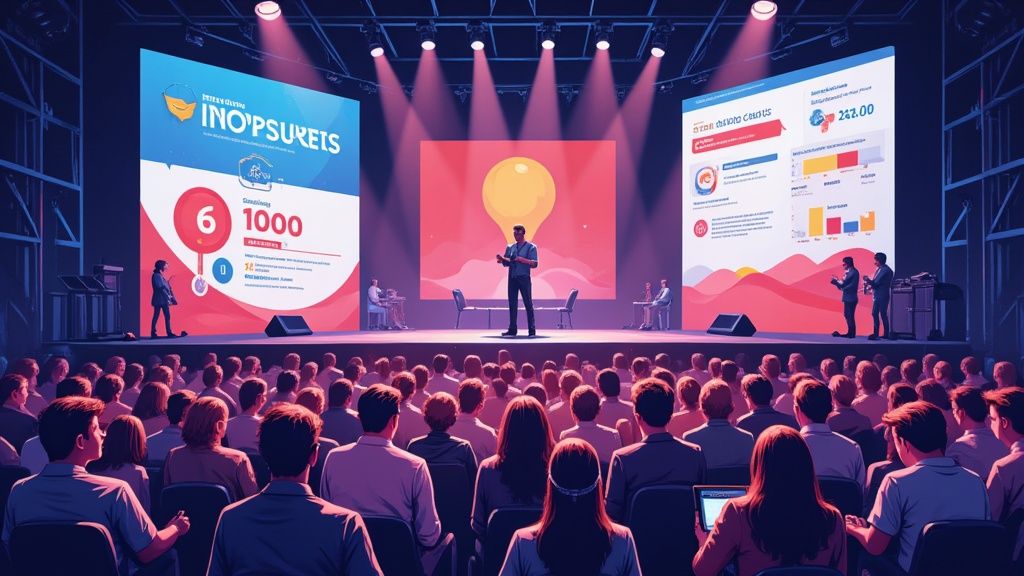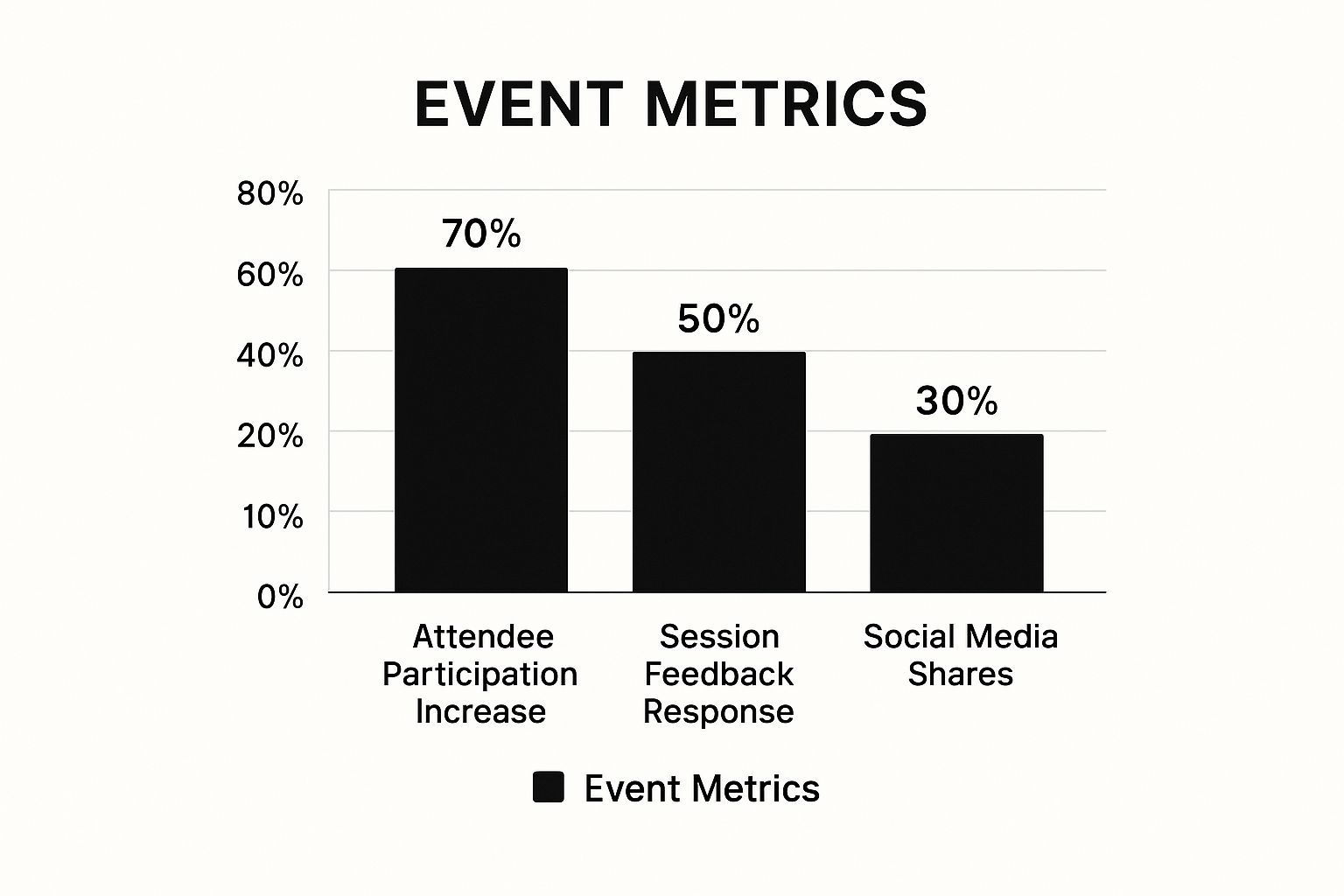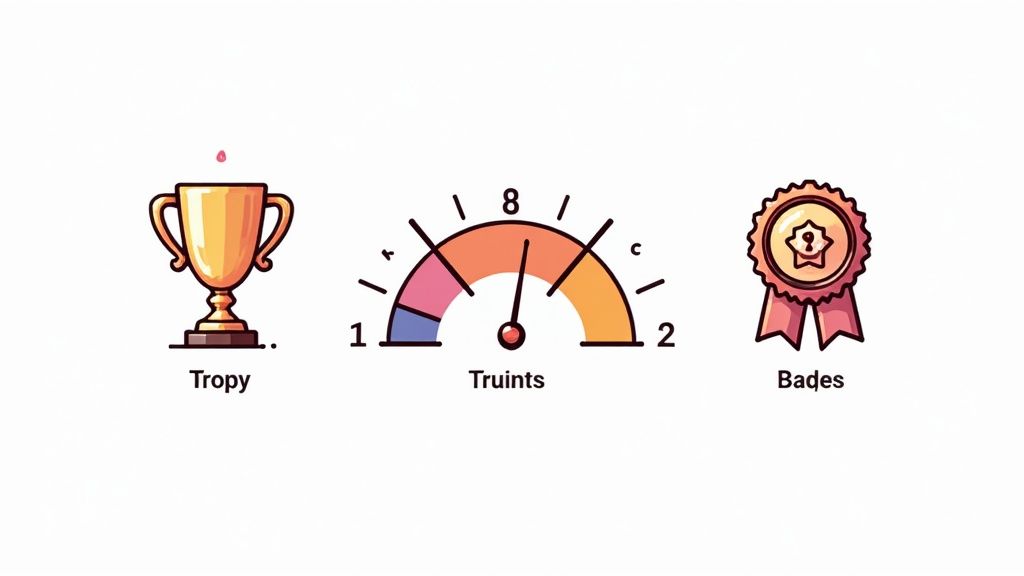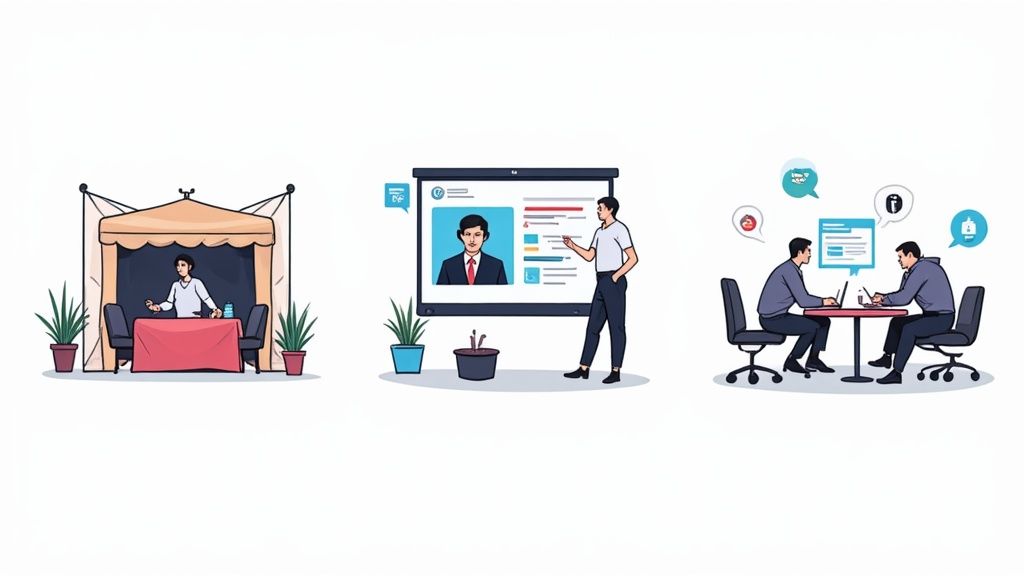Gamification for Events: A Guide to Maximizing Sponsor ROI
Discover how gamification for events can transform attendee engagement and sponsor value. Get proven strategies to boost your conference ROI.
When you hear "gamification for events," you might picture something frivolous, like adding silly games to a serious professional conference. But that’s a common misconception. In reality, it’s a powerful strategy that uses core game mechanics—think points, badges, and leaderboards—to turn passive attendees into active, engaged participants.
This isn't about distraction; it's about direction. By weaving these elements into the event experience, you can create real, measurable value for your sponsors and solve some of the most persistent event challenges. As an aggregator of conference and sponsorship data, we've seen firsthand how gamification delivers the hard metrics sponsors crave.
Unlocking Attendee Engagement Through Gamification

At its heart, gamification is a tool for guiding behavior. It helps you tackle those all-too-familiar problems: low attendance at key sessions, awkward networking lulls, and sponsors standing alone at their booths. It gives your attendees a clear, structured path to follow, nudging them toward the very actions that deliver value to your sponsors.
This marks a huge shift away from the traditional, passive event model. Instead of just hoping people will visit a sponsor, you give them a compelling reason to do so. For example, an attendee might scan a QR code at a booth to earn points or a digital badge. Suddenly, that simple action contributes to their rank on a public leaderboard, tapping into our natural desire for competition, achievement, and a little bit of recognition.
Turning Event Goals into an Engaging Quest
The real magic happens when you align these gamified activities with your event's core objectives. Every conference has a purpose, whether it's generating qualified leads for sponsors or launching a new product. Gamification transforms these business goals into a kind of "quest" for attendees to complete.
Think about how this alignment works on the ground:
- Driving Sponsor ROI: You could create a challenge that requires attendees to collect "digital stamps" from five key sponsors. This guarantees those exhibitors get valuable foot traffic and the chance to have real conversations.
- Encouraging Networking: Points can be awarded for making new connections through the event app. This simple incentive helps break the ice and facilitates introductions that might not have happened otherwise.
- Boosting Content Engagement: Want to make sure a crucial keynote is packed? Offer bonus points for checking in or answering a quick poll about the session’s content.
By reframing key business objectives as interactive challenges, gamification gives you a clear, data-driven way to measure engagement and prove value. Sponsorship stops being a game of chance and becomes a game of strategy.
This creates a scenario where everyone wins. Attendees get a more memorable and interactive experience, organizers hit their engagement metrics, and sponsors see a direct, quantifiable return on their investment. That kind of data makes it much easier to justify sponsorship costs and build strong, lasting partnerships for future events.
Why Gamification Drives Unmatched Sponsor Value
For sponsors, the traditional conference model often feels like a shot in the dark. Their success is tied to random foot traffic and quick, often forgettable, conversations at their booth. It’s an environment that makes proving a real return on investment (ROI) a massive headache. Gamification completely changes this dynamic. It creates a structured, data-rich ecosystem where sponsor value isn't just a hopeful outcome—it's actively engineered.
Instead of waiting for attendees to wander by, a gamified event gives them a reason to seek sponsors out. Think about a simple challenge in the event app: "Visit Sponsor X, learn about their new product, and scan their QR code to earn 100 points." Suddenly, a passive booth visit becomes a specific, goal-oriented mission. This guarantees sponsors a consistent flow of genuinely engaged prospects, not just passersby.
From Impressions to Meaningful Interactions
This is the core shift: moving from counting passive impressions to measuring active engagement. Every QR code scanned, every challenge completed, and every badge unlocked at a sponsor's booth becomes a tangible data point. This process naturally filters for qualified leads—people who have deliberately sought out information, rather than just grabbing free pens on their way to the next session.
By guiding attendee behavior toward specific, high-value actions, gamification ensures that sponsors connect with the most relevant and interested participants. It moves the needle from counting eyeballs to counting meaningful conversations and qualified leads.
The data that flows from these interactions is pure gold. As the largest aggregator of conference and sponsorship data, we know that demonstrable metrics are everything. A gamified approach provides sponsors with clear, undeniable reports on booth traffic, dwell time, and the quality of leads generated. This makes justifying their event spend easier than ever. It's a strategy that pays dividends, especially for larger gatherings like those found in the financial independence group events calendar.
Data Driven Insights for Future Sponsorships
Beyond the immediate ROI for this year's event, gamification hands organizers a treasure trove of behavioral data. You can see precisely which sponsor booths were most popular, which sessions sparked the most activity, and how attendees physically moved through the venue. This kind of information is invaluable for honing your sponsorship packages for next year.
The lift in engagement is significant and measurable.

The numbers tell a clear story: when you incentivize actions, people participate more. In fact, integrating game mechanics like points and leaderboards can boost overall attendee engagement by up to 150% compared to non-gamified events. This data-backed approach allows you to build stronger, more compelling sponsorship tiers based on proven attendee behavior, which is the foundation for creating lasting, high-value partnerships.
The table below breaks down exactly how gamification elevates key sponsorship metrics, moving from ambiguous outcomes to measurable, high-value results.
Comparing Sponsorship Impact Traditional vs Gamified Events
| Sponsorship Metric | Outcome in a Traditional Event | Outcome in a Gamified Event |
|---|---|---|
| Lead Generation | Passive and untracked; relies on manual badge scans or business card drops. | Active and tracked; generates a pre-qualified list of attendees who completed specific actions. |
| Booth Traffic | Relies on chance, booth location, and giveaways to attract random foot traffic. | Driven by targeted challenges, ensuring a steady stream of motivated visitors. |
| Brand Recall | Low; attendees might grab swag but forget the core message minutes later. | High; interaction is tied to learning a key fact, creating a memorable brand touchpoint. |
| ROI Measurement | Difficult and often based on anecdotal evidence or vanity metrics like "impressions." | Clear and data-driven; based on number of interactions, leads captured, and dwell time. |
| Engagement Quality | Superficial; often quick, shallow conversations with unvetted attendees. | Meaningful; interactions are with attendees who have a demonstrated interest in the sponsor's offerings. |
Ultimately, gamification provides the hard data that sponsors have always wanted but could rarely get. It turns sponsorship from a speculative expense into a quantifiable, strategic investment.
The Core Mechanics of Event Gamification

To really make gamification for events work, you have to get inside the "why." These mechanics aren't just flashy features in an app; they're well-understood psychological triggers that shape how people behave. They also happen to generate incredibly valuable data for your sponsors.
The most reliable place to start is with what we call the "PBL trifecta"—Points, Badges, and Leaderboards.
Think of Points as the instant gratification engine. They give attendees immediate, positive feedback that their action was seen and counted. This creates a satisfying sense of progress that keeps them wanting to do more.
Badges, on the other hand, are all about status and recognition. They function like digital trophies, giving people social currency within the event's community. Earning a "Networking Ninja" badge for making ten new connections just feels more significant than racking up an arbitrary number of points.
How Points, Badges, and Leaderboards Work Together
These three elements are designed to feed into one another, creating a system that is both rewarding and competitive. While points and badges celebrate individual achievements, Leaderboards bring in a powerful social dynamic.
Seeing your name climb a list relative to your peers is a huge motivator. It sparks a natural sense of friendly competition, pushing people to complete just one more challenge to get ahead.
Here’s a quick breakdown of how this plays out at a typical conference:
- The Action: An attendee stops by a premier sponsor’s booth to watch a quick product demo.
- The Mechanic: They scan a QR code and instantly get 50 points.
- The Recognition: That scan also unlocks a custom "Innovator" badge from the sponsor, which shows up on their public event profile.
- The Competition: Those 50 points bump them up the main event leaderboard, fueling that competitive drive.
In just a few seconds, a passive booth visit becomes a dynamic, multi-layered interaction that is also completely trackable.
Going Beyond the Basics: Sponsor-Focused Mechanics
The PBL framework is your foundation, but a truly strategic approach ties every single game mechanic directly to sponsor goals. The aim isn't just engagement for its own sake; it's to drive specific, high-value actions that produce a measurable return. For a closer look at how technology can improve these interactions, it's worth reviewing some core customer engagement best practices.
Here are a few other powerful mechanics that put sponsors front and center:
- Sponsor-Specific Challenges: Forget generic tasks. Create targeted challenges like, "Ask a question during Sponsor Acme's keynote" or "Schedule a follow-up meeting with a rep from Innovate Corp." These actions are pure gold for lead generation.
- Virtual Currency: Let attendees earn a special event currency for engaging with sponsors. They can then cash it in for exclusive swag, raffle entries, or access to premium content. This creates a direct, transactional reason to visit exhibitors.
By designing mechanics around sponsor goals, you transform the event app from a simple schedule into a powerful lead-generation engine. Every point awarded and badge earned becomes a data point proving sponsor ROI.
At the end of the day, these mechanics are tools to direct attention and add structure to the event experience. You can use team-based competitions to break the ice and encourage networking, or design a scavenger hunt that guarantees foot traffic across the entire exhibition hall. The key is to choose each mechanic not because it's new and shiny, but because it delivers tangible results for your sponsors.
Designing a High-ROI Event Gamification Strategy
A truly effective gamification strategy isn’t something you just stumble into. It’s meticulously built, piece by piece, with a clear blueprint connecting every game element to a real business outcome. This is how you guarantee your efforts deliver a tangible return for you and your sponsors.
The whole process kicks off long before the event doors swing open. It starts with defining specific, measurable objectives. Vague goals like “boost engagement” just won’t cut it. You need to get granular.
For instance, a much stronger objective would be to increase qualified leads for premier sponsors by 30%. Another could be to drive feedback submissions for keynote sessions up by 50%. These hard numbers give your strategy a clear destination and a benchmark for success.
Define Your Goals and Target Behaviors
With your objectives locked in, the next step is to pinpoint the exact attendee behaviors that will get you there. If a sponsor needs more leads, the target behavior is getting attendees to their booth for a meaningful conversation. If your goal is knowledge sharing, the target behavior is active participation in a session Q&A.
This mapping is absolutely crucial. It ensures every point, badge, or challenge you introduce has a purpose and isn’t just a fun distraction.
- Objective: Drive traffic to exhibitor booths tucked away in the back of the hall.
- Target Behavior: Attendees physically visiting and scanning a QR code at those specific booths.
- Game Mechanic: A "Hidden Gems" challenge that awards a hefty point bonus for visiting these less-trafficked exhibitors.
This straight line from objective to behavior to mechanic is the bedrock of any high-ROI strategy. For anyone planning their next major event, checking out a directory of top event management conferences can be a great way to see what's working in the industry right now.
Select the Right Mechanics and Theme
Once you know which behaviors you want to encourage, you can pick the right game mechanics for the job. A classic leaderboard is perfect for sparking competition around actions like lead scanning. On the other hand, collaborative team challenges are far better for encouraging networking and breaking the ice. The trick is to match the psychological trigger of the mechanic to the action you want to see.
A great theme ties it all together, making the whole experience feel less like a chore and more like an immersive journey. Think of a "Mission to Innovate" theme for a tech conference. Suddenly, visiting sponsor booths becomes "intelligence gathering," and attending a session is a "skill upgrade."
A well-designed theme transforms a collection of disconnected tasks into a compelling narrative. It gives context to the challenges and makes participation feel more like an adventure than a checklist.
To really dial up the engagement and value, you can weave in powerful user-generated content strategies for events within your game. For example, a photo challenge that asks attendees to share pictures from sponsor booths on social media kills two birds with one stone. It fulfills a game objective while also amplifying your event's reach, delivering incredible value for sponsors long after the conference is over.
Real-World Examples of Gamification That Worked
Theory is great, but seeing gamification for events in action is where the real "aha" moment happens. When you move past the concepts and look at actual case studies, you get a clear blueprint for how smart game mechanics can deliver serious, measurable results for sponsors.
The Trade Show Scavenger Hunt
Let's break down a classic scenario from a major industry trade show. The top-tier sponsors had a huge goal: double the number of qualified leads they got last year. Instead of just hoping for foot traffic, the organizers built a scavenger hunt right into the event's mobile app.
It was simple. Attendees earned points for visiting sponsor booths, scanning a QR code, and answering one quick question about what that sponsor actually does. This turned a passive booth visit into an active mission. The results? Premier sponsors saw a 115% increase in qualified leads, blowing past their original target. They weren't just collecting random badge scans; they were having conversations with people who were already engaged.
Sparking Collaboration at a Corporate Conference
Here's another great example, this time from a large company's internal conference. Their main problem was that different departments just didn't talk to each other. The goal wasn't leads; it was to break down those silos and get people collaborating.
To tackle this, they created a team-based leaderboard. Before the event, everyone was assigned to a mixed team—people from sales, engineering, marketing, and HR all thrown in together.
Teams scored points for doing things that forced them to mingle:
- Connecting with someone from a different department (which they verified through the app).
- Attending a breakout session that wasn't in their usual wheelhouse.
- Solving daily industry-specific "riddles" together as a team.
The shift was immediate and obvious. People who would normally never interact were suddenly strategizing together. The proof was in the post-event survey: there was a 70% jump in attendees who said they made valuable connections outside their own department.
These wins are exactly why the gamification industry is projected to hit nearly $190.87 billion by 2034. It’s not just about fun and games; it’s about proven business impact.
Ultimately, these stories show that when you have a clear goal and the right mechanics, gamification is an incredibly powerful tool. Whether you're trying to boost sponsor ROI or just get your own teams talking, the core ideas are the same. A great next step is to see what's new in the field by attending an innovative tech for events conf. When you design the game around a specific outcome, you create an experience that attendees love and stakeholders value.
The Future of Event Tech and Gamification

Gamification in events is evolving far beyond the simple points-and-leaderboard model we're used to. It's becoming a much smarter, more deeply integrated part of event strategy, powered by serious personalization and even better data.
New technologies are making these experiences more compelling for attendees and, just as importantly, far more trackable for sponsors. This isn't just a fun add-on anymore; it's solidifying its place as a must-have tool for proving an event's value.
You just have to look at the market growth to see where this is headed. Valued at USD 6.33 billion back in 2019, the global gamification market is projected to hit a staggering USD 89.75 billion by 2031. That kind of explosion is driven by a real, tangible demand for deeper engagement and measurable returns. For a closer look at the numbers, you can explore detailed gamification market analysis.
Personalized Journeys with AI
The next big step is personalization driven by AI. Think about an event app that does more than just throw a generic scavenger hunt at everyone. Instead, it tailors the challenges to each person based on their job title, stated networking goals, and even their behavior at the event. It essentially creates a unique "quest" for every single attendee.
- A Sales Executive might get a series of challenges that guide them toward meeting specific sponsors in their ideal client profile.
- A Software Developer, on the other hand, could be prompted with tasks related to technical workshops or booths showing off the latest developer tools.
When the experience is this personalized, it stops feeling like a game and starts feeling like a helpful guide. It steers attendees toward the people and content that will be most valuable for them, which is exactly what sponsors are paying for.
Immersive Activations with Augmented Reality
Augmented Reality (AR) is another area poised to completely change sponsor activations. Forget the static booth with a bowl of candy. Sponsors can now build truly immersive experiences that grab and hold attention. Imagine an attendee pointing their phone at a sponsor's logo to trigger a 3D product demo that pops up right on the table, or an AR scavenger hunt where digital clues are layered over the physical event space.
These AR experiences turn passive observation into active participation. They create memorable, "wow" moments that dramatically boost brand recall and give sponsors a genuinely fresh way to connect with their audience.
Underpinning all of this is a more sophisticated approach to data. Every personalized challenge, every AR interaction, creates a rich stream of data points. Organizers and sponsors can see exactly how attendees are moving through the event, what they’re engaging with, and for how long. It’s the kind of concrete, undeniable proof of engagement that makes calculating sponsor ROI easier than ever.
Common Questions About Gamification for Events
When event organizers first consider adding gamification to their strategy, a few practical questions almost always come up. It's perfectly normal to wonder about the cost, whether it's just a distraction, and how to measure the return. As a data company focused on conferences, we see these questions all the time.
The first question is usually about the budget. People hear "gamification" and immediately see dollar signs, but it doesn't have to break the bank.
Your investment can be as simple as using the QR code scanner already built into your event app—a surprisingly effective and low-cost tactic. Of course, you can scale up to more sophisticated platforms or even augmented reality experiences, but the smart move is to match the spend to your specific goals, like boosting sponsorship revenue.
How to Justify the Investment
Next, there's the big one: "Won't this just distract people from the actual conference content?" It's a valid concern, but when designed thoughtfully, gamification does the exact opposite.
A good gamification strategy doesn't pull people away from the main event; it steers them directly toward it. You can build challenges that reward attendees for visiting sponsor booths, sitting in on keynotes, or engaging with specific sessions. It becomes a fun, structured guide to experiencing the best your event has to offer.
The goal of gamification is not to distract but to direct attention. It provides a structured path for attendees, ensuring they interact with the content and sponsors that matter most.
Finally, we get to the crucial question of measuring ROI. This is where a data-first mindset really pays off. You don't have to guess if it worked; you can prove it by tracking the exact behaviors you wanted to encourage.
- Sponsor Value: Did sponsors see more foot traffic? You can track this easily with app check-ins at their booths.
- Lead Generation: How many high-quality leads came directly from gamified activities?
- Content Engagement: Did session attendance climb? Did you get more feedback submissions than last year?
When you compare these metrics to past events that didn't use gamification, you'll have a clear, compelling story to tell about its impact. The numbers will speak for themselves.
Ready to find the perfect conference to sponsor or attend? With the most comprehensive data on thousands of events, ConferenceDatabase helps you make smarter, data-driven decisions. Discover your next high-value opportunity.